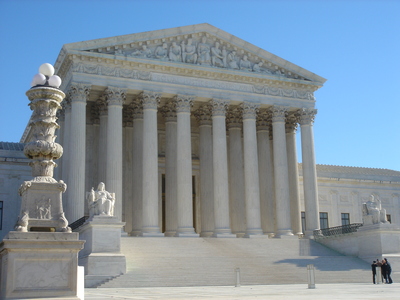Deconstructing Today’s U.S. Supreme Court Arguments in Utility Air Regulatory Group
The EPA Could Well Lose This Challenge to Its Greenhouse Gas Reduction Efforts

The Supreme Court heard oral arguments today in the most important environmental law case of the current Term: Utility Air Regulatory Group v. Environmental Protection Agency. Based on those arguments–and, more importantly, the justices’ questions and comments–it appears that EPA’s efforts to regulate greenhouse gas (GHG) emissions from stationary sources under the Clean Air Act’s Prevention of Significant Deterioration (PSD) program are in serious trouble.
It’s always rather hazardous to predict the outcome in U.S. Supreme Court cases based simply on oral arguments. So readers should take the observations that follow with a grain of salt. But here goes…
It seemed early in the arguments that there were four solid votes–Ginsburg, Breyer, Sotomayor and Kagan–for EPA’s position that its tailored efforts to regulate GHG emissions under the PSD program pass muster under the CAA. Indeed, Justice Sotomayor mused from the bench that this case presents “the apex of Chevron deference” and is the “quintessential area where we give deference to agency discretion” under established principles of administrative law.
But experienced legal advocates counsel that in the Supreme Court, one has to be able to count to five. And there doesn’t appear to be a critical fifth vote on the Court to uphold the EPA position.
From their questioning, Chief Justice Roberts, Justice Alito and Justice Scalia appeared generally supportive of the industry and red state challengers to EPA’s regulatory efforts. Justice Thomas maintained his customary silence at oral argument, but his past votes in related cases suggest he’ll also vote against EPA.
That leaves, as many of us predicted, Justice Anthony Kennedy as the key, deciding vote. So it was a dramatic moment indeed when Kennedy told Solicitor General Donald Verrilli, EPA’s advocate, that “I have to say, I couldn’t find a single precedent that supports your position.” It didn’t help that the only response Verrilli could muster was to cite a shipping case that he conceded the government had not bothered to cite in its written arguments.
Things got worse when Justice Kagan asked Verrilli what she termed “the question that every lawyer hates”–i.e., if the government is to lose the case, on what ground(s) should the adverse decision be based? Verrilli did a better job of responding this time around, suggesting a theory that would not do major violence to EPA’s still-evolving program of regulating GHG emissions–the proverbial “soft landing”.
The good news is that the justices (with the possible exception of Justice Scalia) showed no appetite for revisiting their 2007 ruling that GHGs are “air pollutants” subject to regulation under the CAA. Nor do they appear inclined to abandon the view–at least intimated in the Court’s 2012 American Electric Power v. Connecticut decision–that EPA has the authority to regulate stationary, as well as vehicular, sources of GHGs under the CAA.
So the key questions are likely reduced to two: how will the nine justices vote in Utility Air, and how broad or narrow a decision will it be? The answers to those questions are actually related: if the justices adhere to the positions they espoused at oral argument, a 5-4 decision in favor of petitioners seems most likely, with Justice Kennedy providing the crucial, deciding vote. But the four justices who seemingly support EPA’s position could conceivably trade their votes for a unanimous or near-unanimous opinion that rules against EPA quite narrowly, thereby doing minimal violence to EPA’s long-term climate change and CAA objectives. In recent years, Justice Ginsburg in particular has played this Henry Clay/”Great Compromiser” role most effectively in environmental cases.
In short, it appears that the most likely outcome in Utility Air is a relatively narrow loss for the government, but one that provides a temporary setback to EPA’s efforts to regulate GHGs from stationary sources under the Clean Air Act, rather than a major, resounding defeat.
A final thought I took away from the Supreme Court is how clumsy a tool the Clean Air Act is proving to be in addressing the enormous challenges presented by GHG emissions and climate change. EPA deserves considerable sympathy in attempting to do the best it can to administer that 20th century statute to address the critical 21st century crisis that is climate change. But Congress remains in full gridlock mode and unlikely to enact comprehensive climate change legislation anytime soon. So the Clean Air Act will remain the legislative crucible in which legal battles over regulatory efforts to control GHG emissions will continue to be fought.
Reader Comments
One Reply to “Deconstructing Today’s U.S. Supreme Court Arguments in Utility Air Regulatory Group”
Comments are closed.







Critical 21st century crisis? Seventeen years of stable temperatures with rising co2 concentrations. Crisis, pfft.